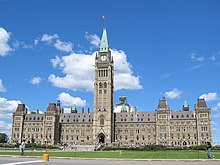Canadian Human Rights Act

 Clash Royale CLAN TAG#URR8PPP
Clash Royale CLAN TAG#URR8PPP
| Canadian Human Rights Act | |
|---|---|
 | |
| An Act to extend the laws in Canada that proscribe discrimination | |
| Citation | R.S.C. 1985, c. H-6. |
| Enacted by | Parliament of Canada |
| Date assented to | 1977 |
| Part of a series on the |
| Constitution of Canada |
|---|
 |
Constitutional history |
|
Document list |
|
Constitutional law |
|
Politics of Canada portal |
The Canadian Human Rights Act[1] (the Act) is a statute passed by the Parliament of Canada in 1977 with the express goal of extending the law to ensure equal opportunity to individuals who may be victims of discriminatory practices based on a set of prohibited grounds such as sex, sexual orientation, race, marital status, gender identity or expression, creed, age, colour, disability, political or religious belief.
Contents
1 Application
2 Specific provisions
2.1 Gender identity and expression
2.2 Hate messages
3 See also
4 References
5 External links
Application
The Act applies throughout Canada, but only to federally regulated activities; each province and territory has its own anti-discrimination law that applies to activities that are not federally regulated.
The Canadian Human Rights Act created the Canadian Human Rights Commission that investigates claims of discrimination as well as the Canadian Human Rights Tribunal to judge the cases.
Before a case can be brought to the Tribunal it must go through several stages of investigation and remediation by the Commission. After this process has been completed, if the parties are not satisfied, the case will go to the tribunal.
If a complainant can show a valid case of discrimination the defendant can rebuke it by showing that their practice was for a justified reason. The process is generally known as the "Meiorin test" which is similar to the Oakes test justification in a Charter challenge.
Specific provisions
Gender identity and expression
In 2016, the government of Prime Minister Justin Trudeau introduced An Act to amend the Canadian Human Rights Act and the Criminal Code (C-16) in the House of Commons of Canada, to add and include "gender identity or expression" to the legislation. The bill passed the Commons on November 18, 2016, and the Senate on June 15, 2017. It received royal assent on June 19, 2017. The law went into effect immediately.
Hate messages
In June 2012, the House of Commons voted to repeal Section 13(1) of the Canadian Human Rights Act regarding communication of hate messages.[2] On June 26, 2013, Section 13(1) was repealed after a vote in the Senate.[3]Royal Assent was given to the bill on July 1, 2013.
See also
- List of anti-discrimination acts
- Human rights in Canada
- Human rights complaints against Maclean's magazine
- Censorship in Canada
- Hate speech laws in Canada
- Canadian Charter of Rights and Freedoms
- Canadian Bill of Rights
- Canadian Human Rights Commission
- Canadian Human Rights Commission free speech controversy
- Employment equity (Canada)
- Equal pay for women
- Veterans' Bill of Rights
- Ontario Human Rights Code
- Quebec Charter of Human Rights and Freedoms
References
^ Original citation: S.C. 1976-77, c. 33, s. 1; current citation: R.S.C. 1985, c. H-6.
^ Jonathan Kay (7 June 2012), "Good riddance to Section 13 of the Canadian Human Rights Act", National Post
^ NP: "Hate speech no longer part of Canada’s Human Rights Act" 27 Jun 2013
External links
Canadian Human Rights Act (full text)- Canadian Human Rights Commission
- Canadian Human Rights Tribunal
- Maple Leaf Web: The Canadian Human Rights Act: Introduction to Canada’s Federal Human Rights Legislation